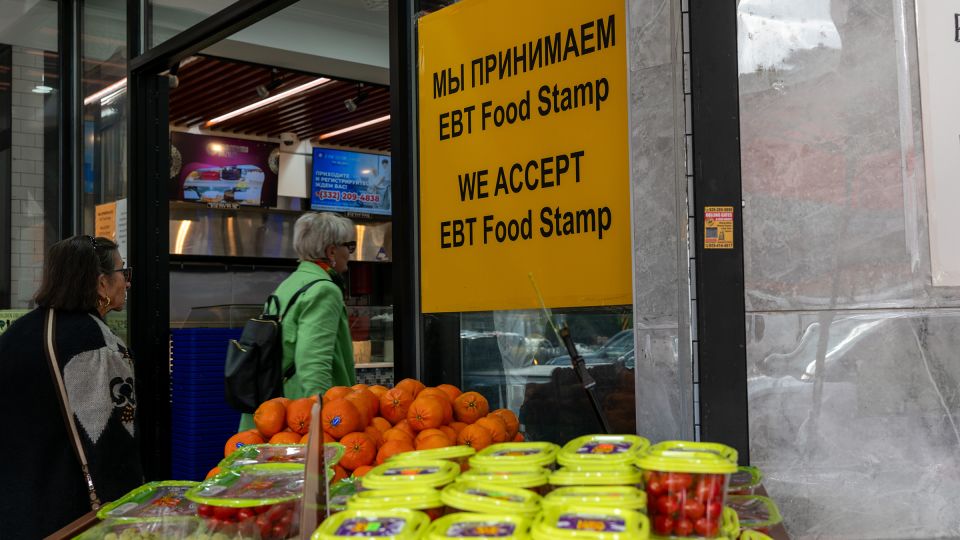Some 2.4 million fewer Americans, including families with children, are forecast to receive food stamps benefits in an average month after Republican lawmakers expanded work requirements to some parents, older enrollees and others as part of President Donald Trump’s agenda law, according to a Congressional Budget Office analysis released Monday.
And other recipients are expected to see their monthly assistance shrink – at a time when grocery prices remain high and food banks are trying to cope with increased demand.
The law requires parents of dependent children to work for their food stamp benefits for the first time. However, fewer people will lose nutrition assistance under the final version of the sweeping tax and spending cuts package that Trump signed into law last month, compared to the bill passed by the House earlier this year.
That version called for requiring parents of children ages 7 and older to work, which would have led to enrollment dropping by 3.2 million people in an average month, a CBO analysis of the House bill found.
The CBO released several reports that looked at the impact of different provisions of the law – which enacts the historic cuts to the nation’s safety net program, while providing trillions of dollars in tax relief – on those who receive food stamps, Medicaid and Affordable Care Act coverage through fiscal year 2034. It also examined how the package will affect Americans with different incomes, finding that the lowest-income households would see their incomes fall, while the richest would receive a notable bump.
The Supplemental Nutrition Assistance Program, or SNAP, as food stamps are formally known, has long required certain able-bodied adults to work to receive benefits for longer than three months. But the GOP’s “big, beautiful bill” broadened that mandate to parents of dependent children – requiring that those with kids ages 14 and older to work, volunteer or participate in job training at least 80 hours a month.
Also, the law requires that adults ages 55 to 64, veterans, people experiencing homelessness and former foster care youth to meet the mandate, though it exempts Native Americans. It also makes it harder for states to receive waivers during difficult economic times.
Among those losing coverage in an average month will be 300,000 adults who live with children ages 14 and older, CBO estimated.
Another controversial provision requires certain states to pick up the share of food stamp benefit costs for the first time. States with payment error rates of at least 6% will have to shoulder between 5% and 15% of the tab, starting in fiscal year 2028. This could prompt some states to cut back on benefits or eligibility or even leave the program, CBO found.
This measure is forecast to reduce or eliminate food stamp benefits for about 300,000 people in an average month. Also, about 96,000 children will receive smaller subsidies through child nutrition programs.
Under the House bill, by contrast, states would have had to pay a larger share of the costs, prompting them to reduce or eliminate benefits for about 1.3 million people in an average month and affecting about 420,000 children.
Other provisions in the law, including changes to the formula that determines families’ monthly assistance, are projected to decrease benefits for certain households.
Many food stamp enrollees are employed, but they may get caught up in red tape trying to report their work or hold jobs without consistent hours, said Gina Plata-Nino, interim SNAP director at the left-leaning Food Research & Action Center.
“People are trying to make ends meet,” she said. “They will be hungrier, they will be sicker without that help.”
The elimination of this support will come at a time when more people will also lose their health insurance, she noted.
The law requires certain Medicaid enrollees – including parents of children ages 14 and older – to work for the first time. This measure will lead to 5.3 million more people being uninsured in 2034, according to the CBO analysis.
Overall, the package’s Medicaid measures are forecast to lead to 7.5 million more Americans without insurance, while changes to the Affordable Care Act will lead to 2.1 million more people being insured. In total, 10 million more Americans will not have health insurance by 2034.
Who comes out ahead
While the law will boost incomes of Americans, on average, it will not benefit everyone, the CBO found. The cuts to the safety net will outweigh the tax reductions for the lowest-income households.
Those at the bottom of the income ladder, who earn less than $24,000, on average, from wages and other income streams, will see their projected incomes drop by about $1,200 a year, or 3.1%, between 2026 and 2034 – mainly from reductions in benefits, including Medicaid and food stamps.
Middle-income Americans, who earn about $86,000, on average, will get an $800 bump, or about 0.8%, according to the analysis.
But the highest earners, with incomes of nearly $700,000, on average, will see a $13,600 jump in their incomes, or about 2.7%.
The wealthiest 10% will receive 63% of the “spoils” of the package, Justin Wolfers, an economics professor at the University of Michigan, posted on X. By contrast, the bottom 60% will receive 4%.
For more CNN news and newsletters create an account at CNN.com

